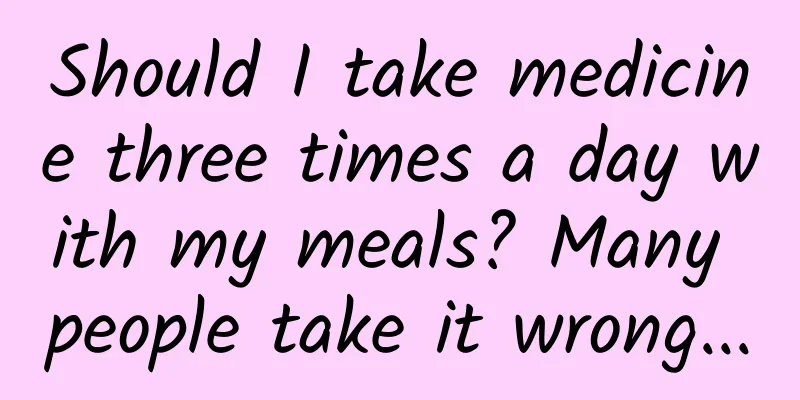Should I take medicine three times a day with my meals? Many people take it wrong...

|
When we take medicine, we often see "three times a day" written on the instructions. Many people will take it once in the morning, noon, and evening when eating. But in fact, most of the three times a day medication has nothing to do with meals. Let's start from the beginning about the frequency of taking medicine every day. Once a day Let's talk about once a day. It means taking it once a day at the same time . The " same time " is important. For example, every morning or evening. Some drugs have a prescribed time for taking the drug in the instructions, which shall prevail. For example, dexamethasone or prednisone should be taken after a meal in the morning to increase efficacy and reduce side effects. Twice daily If the dosage is indicated twice a day, it means once in the morning and once in the evening, about 12 hours apart , such as cefixime. Copyright images in the gallery. Reprinting and using them may lead to copyright disputes. Three times a day Now to the point. The most common misunderstanding about three times a day is that it means taking the drug once a day, in the morning, at noon and at night. Note that it is not breakfast, lunch or dinner. Here it means taking the drug about 8 hours apart , which is defined as 24 hours a day divided by three times. If we follow the time of three meals, then the time between dinner and breakfast the next morning is too long, which will affect the stability of the drug concentration in the body . For example, for antibacterial drugs, anti-epileptic drugs, drugs for treating parkinsonism, antihypertensive drugs, etc. that require high blood drug concentration stability, the efficacy may be seriously affected. The time between breakfast and lunch, or lunch and dinner, must be less than eight hours, which may cause high drug concentrations and increase the risk of adverse reactions. What's more, our meal times may not be regular. In any case, it is not rigorous to use meals to calculate the time to take medicine. If it is difficult to strictly take the medicine every 8 hours, for example, if the child sleeps for a long time, there is no need to wake up the sleeping child to take the medicine. For example, for oral antibiotics, a difference of two hours is not a big problem. Just make the intervals between dosing as balanced as possible. Once every three meals In addition, nothing is absolute. The time to take some medicines is really related to the time of three meals , such as hypoglycemic drugs and drugs for treating the digestive system. Since the level of blood sugar or gastric acid is related to eating, these two types of medicines should be taken with the time of three meals, not every 8 hours. But this is a minority after all, and there will be special marks in the instructions. For other medicines that do not emphasize taking them at the same time as meals and require taking them three times a day, try to take them every eight hours. Copyright images in the gallery. Reprinting and using them may lead to copyright disputes. Other situations After understanding the most difficult part, “three times a day”, the rest will be easy to understand. Let’s continue. Four times a day, according to the previous idea, it means taking it once every 6 hours , such as 7 o'clock, 13 o'clock, and 18 o'clock. It is similar before going to bed. It also depends on the specific work and rest time. If the sleep time is very long, you may need to wake up in the middle to take the medicine. Regarding the interval between medications, most medications are based on their half-life in the body. Some medications need to maintain a stable concentration, so they need to be taken at fixed times, such as Parkinson's medications that need to be taken every 8 hours, and some medications that need to be taken every 12 hours. But some drugs just remind everyone that the time interval should not be less than the prescribed time interval. For example, acetaminophen requires 4-6 hours between two doses. After we took it, the fever-reducing effect was good. The fever did not come back until 12 hours later. We can also wait 12 hours before taking the second dose. If the fever does not come back later, you can stop taking the medicine at any time. You don’t have to take the medicine according to the interval in the instructions. This type of medicine is taken on demand. To put it bluntly, you can take it when you need it, and don’t take it when you don’t need it. In short, don't be careless about medication. Whether it is the time to take the medication or the method of taking the medication, it is safer to read the instructions several times. If you really have questions, then ask a professional! Planning and production Author: Liu Ziqi, Chief Pharmacist, First Affiliated Hospital of Harbin Medical University Reviewer: Tang Qin, Director of the Science Popularization Department of the Chinese Medical Association, National Health Science Popularization Expert Planning丨He Tong Editor: He Tong Proofread by Xu Lai and Lin Lin |
>>: Is there an "ecological epic" at 31° north latitude? Its name is "Shennongjia"!
Recommend
My 20 operating notes may be helpful to you
It’s the end of August, the tail end of summer, a...
11 hair dryer reviews: Shocking! I bought fake brand products in a live broadcast room! How to distinguish?
Here’s what happened: On this year’s Double Eleve...
Eight "cheating" methods for APP promotion to solve the APP application promotion road
Eight "cheating" methods to promote APP...
What are the requirements for inviting Pixiu?
As we all know, Pixiu is a auspicious animal that...
Should I upgrade to iOS 13.6.2 after Apple pushes it? If my phone still works, I suggest not to upgrade.
Not long ago, Apple pushed the iOS 13.5.1Beta ver...
Building a reinforcement learning API based on TensorFlow: How was TensorForce created?
This article will be centered around a practical ...
The tenth session of Wolf Uncle's Xiaohongshu hot-selling promotion and drainage training course
Course Outline 1. Basic knowledge: Xiaohongshu’s ...
How to create an excellent C-end component library? Let’s take a look at the actual cases of Shell Design!
"Components" are a very important part ...
How to make robots? How to write robots?
How to make robots? How to write robots? For robo...
To save 30 billion in waste, how can IP operations adapt to the correct gameplay?
IP exhibitions are no longer a new way of operati...
In-depth: Momo, Weibo and Kuaishou, the three video giants will eventually face off
Weibo has a market value of 17.2 billion yuan, Mo...
Four key links in O2O operation
Although everyone has been playing with O2O in re...
Can avocados reduce belly fat? 150 overweight people tell you the answer
The surface is bumpy and it is neither sweet nor ...
Changsha tasting tea takeaway tea Yuelu District high-end tea WeChat sharing the most reliable friends tasting tea with its own studio audition
Changsha tea tasting, take-out tea drinking, Yuel...
How much does it cost to develop a WeChat game mini program? How much does it generally cost to develop a WeChat mini program?
Q: How much does it cost to develop a WeChat game...


![Li Xingxing's practical editing training camp will end in January 2022 [HD quality with materials]](/upload/images/67cc10da025be.webp)






